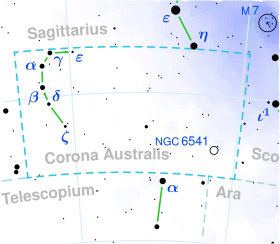Astronomy:HD 167096
| Observation data Epoch J2000.0 Equinox (celestial coordinates) | |
|---|---|
| Constellation | Corona Australis |
| Right ascension | 18h 15m 53.45211s[1] |
| Declination | −44° 12′ 23.2322″[1] |
| Apparent magnitude (V) | 5.45±0.01[2] |
| Characteristics | |
| Spectral type | G8/K0 III[3] |
| B−V color index | +0.96[4] |
| Astrometry | |
| Radial velocity (Rv) | −27±13.7[5] km/s |
| Proper motion (μ) | RA: +67.283[1] mas/yr Dec.: +12.211[1] mas/yr |
| Parallax (π) | 14.5746 ± 0.4724[1] mas |
| Distance | 224 ± 7 ly (69 ± 2 pc) |
| Absolute magnitude (MV) | +0.64[6] |
| Orbit[7] | |
| Period (P) | 1.811595±0.102779 yr |
| Semi-major axis (a) | 8.1±0.9 mas |
| Eccentricity (e) | 0.00 |
| Details | |
| A | |
| Mass | 1.11±0.51[8] M☉ |
| Radius | 8.92±0.45[9] R☉ |
| Luminosity | 32.4±0.7[10] L☉ |
| Surface gravity (log g) | 2.51±0.46[8] cgs |
| Temperature | 4,886±123[11] K |
| Metallicity [Fe/H] | −0.02[12] dex |
| Rotational velocity (v sin i) | <1.6[13] km/s |
| Other designations | |
| Database references | |
| SIMBAD | data |
HD 167096, also known as HR 6818 or rarely 4 G. Coronae Australis, is a binary star[15] located in the southern constellation Corona Australis. It has an apparent magnitude of 5.45,[2] making it faintly visible to the naked eye. The system is located relatively close at a distance of 224 light years based on Gaia DR3 parallax measurements[1] but is drifting closer with a poorly constrained heliocentric radial velocity of −27 km/s.[5] At its current distance HD 167096's brightness is diminished by three tenths of a magnitudes due to interstellar dust[16] and it has an absolute magnitude of +0.64.[6]
The primary has a stellar classification of G8/K0 III,[3] indicating that it is an evolved red giant with the characteristics of a G8 and K0 giant star. It has 1.11 times the mass of the Sun[8] but it has expanded to 8.92 times the Sun's radius.[9] It radiates 32.4 times the luminosity of the Sun[10] from its enlarged photosphere at an effective temperature of 4,886 K,[11] giving it an orangish-yellow hue. It has a near solar metallicity at [Fe/H] = −0.02[12] and spins too slowly for its projected rotational velocity to be measured accurately. This is a binary star that completes a circular orbit within 1.81 years.[7] Since the two components have a separation of only 8.1 mas, it makes it difficult to measure their individual properties.[7]
References
- ↑ 1.0 1.1 1.2 1.3 1.4 Vallenari, A. et al. (2022). "Gaia Data Release 3. Summary of the content and survey properties". Astronomy & Astrophysics. doi:10.1051/0004-6361/202243940 Gaia DR3 record for this source at VizieR.
- ↑ 2.0 2.1 Høg, E.; Fabricius, C.; Makarov, V. V.; Urban, S.; Corbin, T.; Wycoff, G.; Bastian, U.; Schwekendiek, P. et al. (March 2000). "The Tycho-2 catalogue of the 2.5 million brightest stars". Astronomy and Astrophysics 355: L27–L30. ISSN 0004-6361. Bibcode: 2000A&A...355L..27H.
- ↑ 3.0 3.1 Houk, Nancy (1978). Michigan catalogue of two-dimensional spectral types for the HD stars: Declinations −53° to −40°. 2. Bibcode: 1978mcts.book.....H.
- ↑ Corben, P. M. (1966). "Photoelectric magnitudes and colours for bright southern stars". Monthly Notes of the Astronomical Society of South Africa 25: 44. ISSN 0024-8266. Bibcode: 1966MNSSA..25...44C.
- ↑ 5.0 5.1 Kharchenko, N.V.; Scholz, R.-D.; Piskunov, A.E.; Röser, S.; Schilbach, E. (November 2007). "Astrophysical supplements to the ASCC-2.5: Ia. Radial velocities of ~55000 stars and mean radial velocities of 516 Galactic open clusters and associations". Astronomische Nachrichten 328 (9): 889–896. doi:10.1002/asna.200710776. ISSN 0004-6337. Bibcode: 2007AN....328..889K.
- ↑ 6.0 6.1 Anderson, E.; Francis, Ch. (May 2012). "XHIP: An extended hipparcos compilation". Astronomy Letters 38 (5): 331–346. doi:10.1134/S1063773712050015. ISSN 1063-7737. Bibcode: 2012AstL...38..331A.
- ↑ 7.0 7.1 7.2 Malkov, O. Yu.; Tamazian, V. S.; Docobo, J. A.; Chulkov, D. A. (October 2012). "Dynamical masses of a selected sample of orbital binaries". Astronomy & Astrophysics 546: A69. doi:10.1051/0004-6361/201219774. ISSN 0004-6361. Bibcode: 2012A&A...546A..69M.
- ↑ 8.0 8.1 8.2 Allende Prieto, C.; Lambert, D. L. (December 1999). "Fundamental parameters of nearby stars from the comparison with evolutionary calculations: masses, radii and effective temperatures". Astronomy and Astrophysics 352: 555–562. ISSN 0004-6361. Bibcode: 1999A&A...352..555A.
- ↑ 9.0 9.1 Kervella, P.; Thévenin, F.; Di Folco, E.; Ségransan, D. (October 2004). "The angular sizes of dwarf stars and subgiants. Surface brightness relations calibrated by interferometry". Astronomy & Astrophysics 426 (1): 297–307. doi:10.1051/0004-6361:20035930. ISSN 0004-6361. Bibcode: 2004A&A...426..297K.
- ↑ 10.0 10.1 Brown, A. G. A. (August 2018). "Gaia Data Release 2: Summary of the contents and survey properties". Astronomy & Astrophysics 616: A1. doi:10.1051/0004-6361/201833051. Bibcode: 2018A&A...616A...1G. Gaia DR2 record for this source at VizieR.
- ↑ 11.0 11.1 Stassun, Keivan G. et al. (9 September 2019). "The Revised TESS Input Catalog and Candidate Target List". The Astronomical Journal 158 (4): 138. doi:10.3847/1538-3881/ab3467. Bibcode: 2019AJ....158..138S.
- ↑ 12.0 12.1 Anders, F. et al. (August 2019). "Photo-astrometric distances, extinctions, and astrophysical parameters for Gaia DR2 stars brighter than G = 18". Astronomy & Astrophysics 628: A94. doi:10.1051/0004-6361/201935765. ISSN 0004-6361. Bibcode: 2019A&A...628A..94A.
- ↑ De Medeiros, J. R.; Alves, S.; Udry, S.; Andersen, J.; Nordström, B.; Mayor, M. (January 2014). "A catalog of rotational and radial velocities for evolved stars V: Southern stars *". Astronomy & Astrophysics 561: A126. doi:10.1051/0004-6361/201220762. ISSN 0004-6361. Bibcode: 2014A&A...561A.126D.
- ↑ "HD 167096". SIMBAD. Centre de données astronomiques de Strasbourg. http://simbad.u-strasbg.fr/simbad/sim-basic?Ident=HD+167096.
- ↑ Eggleton, P. P.; Tokovinin, A. A. (11 September 2008). "A catalogue of multiplicity among bright stellar systems". Monthly Notices of the Royal Astronomical Society 389 (2): 869–879. doi:10.1111/j.1365-2966.2008.13596.x. ISSN 0035-8711. Bibcode: 2008MNRAS.389..869E.
- ↑ Gontcharov, George A.; Mosenkov, Aleksandr V. (28 September 2017). "Verifying reddening and extinction for Gaia DR1 TGAS main sequence stars". Monthly Notices of the Royal Astronomical Society 472 (4): 3805–3820. doi:10.1093/mnras/stx2219. ISSN 0035-8711. Bibcode: 2017MNRAS.472.3805G.
<ref> tag with name "Gould1879" defined in <references> is not used in prior text.
 |


